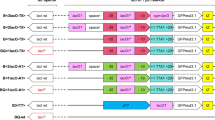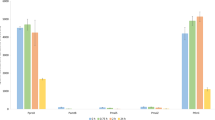Abstract
The cloning and expression of toxic proteins in bacteria have posed a great challenge because of the leaky expression in inducible expression systems. Using artificial gene synthesis and clone screening methods, we identified a mutant T5 promoter, which significantly reduced leaky expression of lac operator. The mutant T5 promoter contains two T deletions at −35 region and may reduce promoter activity. A bacterial lethal gene, Φ174 lytic gene E, was successfully cloned in this system and expressed in the presence of isopropyl β-d-1-thiogalactopyranoside. The system is compatible with existing T5 inducible expression systems and can be used for the controlled expression of toxic proteins.



Similar content being viewed by others
References
Bujard H, Gentz R, Lanzer M, Stueber D, Mueller M, Ibrahimi I, Haeuptle MT, Dobberstein B (1987) A T5 promoter-based transcription-translation system for the analysis of proteins in vitro and in vivo. Methods Enzymol 155:416–433
Gentz R, Bujard H (1985) Promoters recognized by Escherichia coli RNA polymerase selected by function: highly efficient promoters from bacteriophage T5. J Bacteriol 164:70–77
Harley CB, Reynolds RP (1987) Analysis of E. coli promoter sequences. Nucl Acids Res 15:2343–2361
Hutchison CR, Sinsheimer RL (1966) The process of infection with bacteriophage Φ-X174: X. Mutations in a Φ-X Lysis gene. J Mol Biol 18:429–447
Jalava K, Eko FO, Riedmann E, Lubitz W (2003) Bacterial ghosts as carrier and targeting systems for mucosal antigen delivery. Expert Rev Vaccines 2:45–51
Keyes WM, Mills AA (2003) Inducible systems see the light. Trends Biotechnol 21:53–55
Langemann T, Koller VJ, Muhammad A, Kudela P, Mayr UB, Lubitz W (2010) The bacterial ghost platform system: production and applications. Bioeng Bugs 1:326–336
Rossi FM, Blau HM (1998) Recent advances in inducible gene expression systems. Curr Opin Biotechnol 9:451–456
Saida F, Uzan M, Odaert B, Bontems F (2006) Expression of highly toxic genes in E. coli: special strategies and genetic tools. Curr Protein Pept Sci 7:47–56
Szostak MP, Hensel A, Eko FO, Klein R, Auer T, Mader H, Haslberger A, Bunka S, Wanner G, Lubitz W (1996) Bacterial ghosts: non-living candidate vaccines. J Biotechnol 44:161–170
Young KD, Young R (1982) Lytic action of cloned ΦX174 gene E. J Virol 44:993–1002
Acknowledgments
This work was supported by Grant 30500563 from the National Science Foundation of China, Grant NCET-06-0615 (NECT), Grant “A Foundation for the Author of National Excellent Doctoral Dissertation of PR China” from the Ministry of Education of the Republic of China.
Author information
Authors and Affiliations
Corresponding authors
Electronic supplementary material
Below is the link to the electronic supplementary material.
Rights and permissions
About this article
Cite this article
Guo, J., Jia, R. A novel inducible expression system for the functional study of toxic gene in bacteria. World J Microbiol Biotechnol 30, 1527–1531 (2014). https://doi.org/10.1007/s11274-013-1573-0
Received:
Accepted:
Published:
Issue Date:
DOI: https://doi.org/10.1007/s11274-013-1573-0




